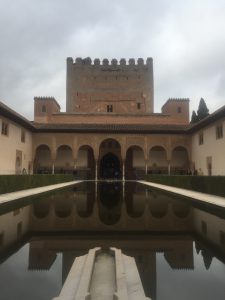
Marcus Hoekstra ‘18
Spain’s beautiful symbiosis of religion
“Wow…that’s great…so what made you study religion?” It’s a common response to a frequent question. What made me study religion? You see, what most people don’t understand, is that the study of spirituality extends far beyond future priests and pastors. First and foremost, as any education is, it is an understanding. It is an introspection into human thought, history, and questions concerning matters greater than oneself, be it spirit or culture. It is the close analyzation of themes, tradition, and the interchange of ideas. No, I never thought I would study it. But yes, I quite enjoy it.
You see, what Wabash has provided me over the past three years is the opportunity to engage with these concepts on a day to day basis. It has sat myself down in a classroom, for hours every week, and pushed me to speak thoughtfully of books taken hundreds, if not thousands of years to writes. No small challenge indeed. It has provided me a foundational understanding on the function of religiosity, its role in this world, and more importantly its place within the human story. So why study religion? Because with these tools, one may begin to better understand current issues such as the ongoing Middle Eastern unrest, disparities in country secularization levels, and their impacts reaching into political, cultural, even economic spheres.

Magical, indeed. However, as Herbert Spencer once said, “the ultimate aim of education is not knowledge but action.” Personally, I could not agree anymore with this statement. Recently this phrase has embodied itself in my life in two very powerful ways. The first, was my immersion trip to Israel this past Fall where we studied ongoing inter religious conflict, commonalities, and influence. The second, and more importantly, has been my semester abroad in Valencia, Spain. During my time here, I have been given the chance to engage with Spanish lifestyle, live with a host family, while loving every moment of it. However, much of Spain’s past and present has not always been as “Spanish” as we know it today. Thanks to the Givens Endowment, I have grown to understand this.
I’ve always had a respect for art. Although not an area that I am the most knowledgeable in, it has always fascinated me in its diversity of styles and periods. Being so, the Givens Scholarship has provided me a chance to deepen my artistic understanding of Western culture. With my grant statement, I chose to focus on the Islamic influence of Western art. What better of a place to begin than Spain? For some 400 years, Muslims controlled much of the Iberian Peninsula, infusing its ideas and styles into a Western-Christian Spain. No better can this be seen than in the architecture and of the Alhambra.
Situated in Granada, Spain, this UNESCO World Heritage is one of the largest palaces in Europe. Bearing the mark of Islamic calligraphy, paintings, and wall decorations, much of the original Muslim foundations stand next to gothic and renaissance era churches. I best observed this in the Nasrid palace, in which beautiful courtyards built by Muslim architects have been renovated by Christian builders.
Below the castle, much of the Granada’s architecture and artistic works possess inter religious influences seen in the Alhambra above. Ornate vaulted arches among the Granada’s cathedrals reminisce of their Islamic origins.
Ultimately, it is to say, that the Givens Scholarship has provided me with the opportunity to apply classroom knowledge to real world experience, deepening my appreciation of Spain’s beautiful symbiosis of religion. The Givens has offered me a chance to delve deeper into one of my final Fall course papers and elaborate on my classes here in Spain. It has been a truly wonderful opportunity. Thanks to the Givens family, this has all been possible.